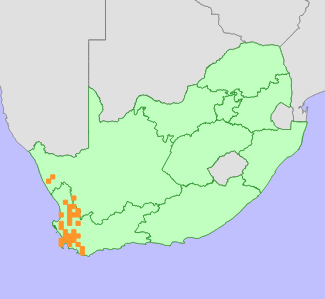|
Scientific Name | Wurmbea stricta (Burm.f.) J.C.Manning & Vinn. |
Higher Classification | Monocotyledons |
Family | COLCHICACEAE |
Synonyms | Anthericum bulbine Houtt., Dipidax rosea Salisb., Dipidax triquetra (L.f.) Baker, Melanthium junceum Jacq., Melanthium triquetrum L.f., Onixotis stricta (Burm.f.) Wijnands, Onixotis triquetra (L.f.) Mabb., Pontederia stricta Burm.f. |
Common Names | Rysblommetjie (a), Waterblom (a) |
National Status |
Status and Criteria | Least Concern |
Assessment Date | 2018/09/30 |
Assessor(s) | L. von Staden |
Justification | Wurmbea stricta is a widespread and common species that is not yet in danger of extinction. It has an extent of occurrence (EOO) of 46 606 km², and is listed as Least Concern. |
Distribution |
Endemism | South African endemic |
Provincial distribution | Northern Cape, Western Cape |
Range | This species is endemic to South Africa, and is found in the Kamiesberg Mountains, southern Knersvlakte, Bokkeveld Mountains, Cape Peninsula to Worcester and Elim. |
Habitat and Ecology |
Major system | Terrestrial |
Major habitats | Breede Alluvium Fynbos, Swartland Alluvium Fynbos, Cape Flats Sand Fynbos, Swartland Shale Renosterveld, Swartland Silcrete Renosterveld, Boland Granite Fynbos, Cape Winelands Shale Fynbos, Kouebokkeveld Alluvium Fynbos, Bokkeveld Sandstone Fynbos, Nieuwoudtville Shale Renosterveld, Breede Shale Fynbos, Swartruggens Quartzite Karoo, Doringrivier Quartzite Karoo, Lourensford Alluvium Fynbos, Northern Inland Shale Band Vegetation, Leipoldtville Sand Fynbos, Hopefield Sand Fynbos, Klawer Sandy Shrubland, Elim Ferricrete Fynbos, Namaqualand Heuweltjieveld, Peninsula Granite Fynbos, Swartland Alluvium Renosterveld, Peninsula Shale Fynbos, Saldanha Flats Strandveld, Namaqualand Blomveld, Greyton Shale Fynbos, Namaqualand Klipkoppe Shrubland, Citrusdal Vygieveld, Tanqua Karoo, Swartland Granite Renosterveld, Peninsula Shale Renosterveld, Western Ruens Shale Renosterveld, Central Ruens Shale Renosterveld, Vanrhynsdorp Gannabosveld, Citrusdal Shale Renosterveld, Kouebokkeveld Shale Fynbos |
Description | It occurs in marshes and pools. |
Threats |
| At least 50% of this species' habitat has been lost to crop cultivation and urban expansion over the past 100 or more years (a period longer than three generations). Many subpopulations remain on isolated habitat remnants, and are threatened by ongoing habitat loss and degradation, particularly due to spreading alien invasive plants and overgrazing. |
Population |
There is no information available on the population of this species.
|
Population trend | Stable |
Assessment History |
Taxon assessed |
Status and Criteria |
Citation/Red List version | | Wurmbea stricta (Burm.f.) J.C.Manning & Vinn. | Least Concern | Raimondo et al. (2009) | |
Bibliography |
Manning, J.C. and Goldblatt, P. 2012. Plants of the Greater Cape Floristic Region 1: The Core Cape Flora. Strelitzia 29. South African National Biodiversity Institute, Pretoria.
Raimondo, D., von Staden, L., Foden, W., Victor, J.E., Helme, N.A., Turner, R.C., Kamundi, D.A. and Manyama, P.A. 2009. Red List of South African Plants. Strelitzia 25. South African National Biodiversity Institute, Pretoria.
Snijman, D.A. 2013. Plants of the Greater Cape Floristic Region 2: The extra Cape flora. Strelitzia 30. South African National Biodiversity Institute, Pretoria.
Vinnersten, A. and Manning, J. 2007. A new classification of Colchicaceae. Taxon 56(1):171-178.
|
Citation |
| von Staden, L. 2018. Wurmbea stricta (Burm.f.) J.C.Manning & Vinn. National Assessment: Red List of South African Plants version 2024.1. Accessed on 2025/12/07 |
 Comment on this assessment
Comment on this assessment

